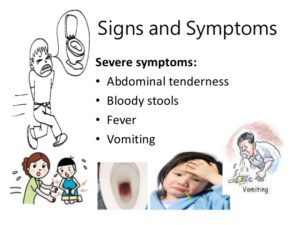
What is Amoebic Dysentery?
An infection of the large intestine is called amoebic dysentery, sometimes it involves the liver.
People whose hygiene is poor are frequently affected.
Amoebiasis is characterized by foul smelling stool, abdominal pain, fever, dehydration and weight loss.
Entamoeba histolytica is an amoeba that is responsible for causing amoebic dysentery.
How do you get amoebic dysentery?
Amoebic Dysentery spread by:
• Drinking contaminated water.
• Eating contaminated raw vegetables and fruits.
• Unprotected oral-anal sexual contact. Entamoeba histolytica exists in contaminated food and drinks in two forms: – Trophozoites or infective cysts. Trophozoites do not cause much harm as they usually die in the stomach due to its acidity. Cysts are resistant to the acidic contents of the stomach. When the cysts reach the intestine, individual amoebae are released from the cysts and causes infection.
How do you know if you have Amoebiasis?
Mild symptoms: • Intermittent diarrhea with foul-smelling stool that may be preceded by constipation.
• Indigestion.
• Blood and mucus in the stool.
• Gas and Abdominal Bloating.
• Dehydration.
• Abdominal cramps and tenderness.
• Weight loss.
• Anemia.
• Fever.
• Fatigue.
• Chills. If the amoebae break through the intestinal wall and peritoneum it causes peritonitis. The amoebae may be then carried in the blood to the liver resulting in the formation of an abscess that presents the following symptoms:
• Fever with a chill.
• Nausea and vomiting.
• Pain in the upper right portion of the abdomen.
• Weight loss.
• Enlarged liver.
Is Amoebiasis contagious?
Yes, Amebiasis is contagious. Wherever living conditions are unsanitary and unhygienic, the chances are higher that the infection will pass from person to person. Anyone carrying amoebas in their intestines can pass the infection to others through the stool.
Is amoebic dysentery fatal?
Firstly, treatment of the underlying infection of amoebic dysentery is important. If remain untreated amoebiasis can lie dormant for years and subsequently lead to severe, fatal, complications. Amoebic dysentery is common in where human feces are used as fertilizer.
What triggers Amoebiasis?
It is a parasitic infection of the intestines caused by the protozoan Entamoeba histolytica, or E. histolytica. The common symptoms include loose stool, abdominal cramping, and stomach pain.
How is amebiasis diagnosed?
The diagnosis of intestinal amoebiasis:
Commonly on microscopic examination of stool
Homeopathic medicines for amoebic dysentery?
Arsenicum album:
Lycopodium clavatum:
Nux vomica:
Podophyllum:
Capsicum:
Argentum nitricum:
Merc. cor:

 If you are unsatisfied with our treatment and do not want to continue the medicines you can ask for refund within 24 hours of making the payment.
If you are unsatisfied with our treatment and do not want to continue the medicines you can ask for refund within 24 hours of making the payment.